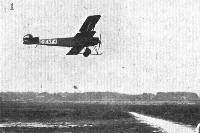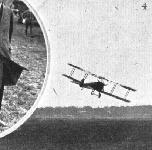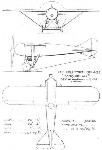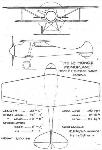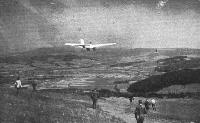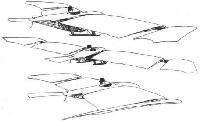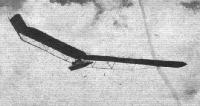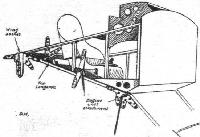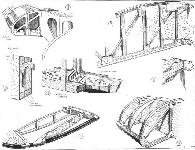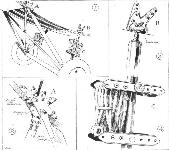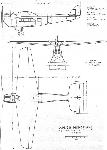Фотографии
-
THE FIRST CROYDON AVIATION MEETING: Two S.E.5.'s come round on their first lap in the second race.
Самолёты на фотографии: RAF S.E.5 - Великобритания - 1916
-
D.H.32 360 HP Rolls-Royce "Eagle" Engine
Самолёты на фотографии: De Havilland D.H.32 / D.H.34 - Великобритания - 1921
-
Tho Holder of the Michelin Cup: The Caudron C.60, on which Poiree made his flight, described in FLIGHT last week. This machine, which is one of the Caudron school types, can if desired be fitted with dual control. It is similar to the machine flown by Poiree at Monaco, except that wheels are fitted instead of floats. The engine is a 130 h.p. Clerget, and the main characteristics are as follows: Length over all, 24 ft. 7 ins. Span, upper plane,. 33 ft. 4 ins. Span, lower plane, 31 ft. 4 ins. Wing area, 270 sq. ft. Weight empty, 1,110 lbs Weight fully loaded, 1,900 lbs.
Самолёты на фотографии: Caudron C.27 / C.59 / C.60 - Франция - 1921
-
Регистрационный номер: J6858 SIDDELEY SINAIA. Designed soon after the first World War, the Siddeley type 103 was a two-motor, long-range, heavy bomber which flew for the first time on 25th June 1921. During 1921, the Siddeley Deasy Motor Car Co., Ltd ., was absorbed by the then new joint holding called Sir W.G.Armstrong, Whitworth Aircraft Ltd, of Coventry - better known today as Armstrong Whitworth Aircraft.
The Sinaia was powered by two 600-h.p. Armstrong Siddeley Tiger engines - the prototype J6858 being painted "bomber green" overall. Provision was also made for the installation of two 480-h.p. Napier Lion engines.
The type 103 Sinaia was designed by Mr. F.M.Green who had joined the Siddeley company after serving on the Royal Aircraft Establishment at Farnborough during the Great War. Unfortunately, records relating to the history and performance of the Sinaia were destroyed by enemy action during World War II. From photographs and drawings three gun positions may be noted - two in rearwards-extended engine nacelles - as well as side-by-side seating for the pilot and navigator/wireless operator.Самолёты на фотографии: Siddeley, Armstrong Whitworth Sinaia - Великобритания - 1921
-
The Mars I biplane.
Самолёты на фотографии: Gloster Mars (Bamel) / Nighthawk / Sparrowhawk - Великобритания - 1921
-
Регистрационный номер: G-EAFH [3] THE FIRST CROYDON AVIATION MEETING: F.G.M.Sparks, on the Renault Avro, winning the first race.
Самолёты на фотографии: Avro Type 548 - Великобритания - 1919
-
Регистрационный номер: G-EAFH [3] THE FIRST CROYDON AVIATION MEETING: The line-up for the third event, the First Croydon Handicap.
Самолёты на фотографии: Avro Type 548 - Великобритания - 1919
-
Регистрационный номер: G-EAFH [3] THE FIRST CROYDON AVIATION MEETING: Sparks takes off on a climbing turn in the third race.
Самолёты на фотографии: Avro Type 548 - Великобритания - 1919
-
The Nieuport-Delage "Sesquiplan." 320 HP. Hispano-Suiza Engine
Самолёты на фотографии: Nieuport-Delage Ni-D-41 / Sesquiplan - Франция - 1921
-
The de Monge biplane.
Самолёты на фотографии: De Monge Lumiere / Type 5.1 - Франция - 1921
-
THE RHON SOARING COMPETITION: The Aachen Glider in Flight. This photograph gives a good idea of the nature of the country over which these gliding and soaring flights are being made.
Самолёты на фотографии: FVA (Flugwissenschaftliche Vereinigung Aachen) FVA-1 Schwatze Duvel/FVA-2 Blaue Maus/FVA-3 Ente - Германия - 1920
-
THE RHON SOARING COMPETITION: Two views of the Aachen glider, which did so well in the turning competition. The attitude and indifference of the cattle indicate that the machine has no engine.
Самолёты на фотографии: FVA (Flugwissenschaftliche Vereinigung Aachen) FVA-1 Schwatze Duvel/FVA-2 Blaue Maus/FVA-3 Ente - Германия - 1920
-
The Rhon Soaring Competition: The Munich glider, which covered a distance of over 2 1/2 miles and remained in the air for over five minutes.
Самолёты на фотографии: Loessl / Bayerischer Aeroklub Munchen SB-1 Munchener - Германия - 1921
-
THE RHON SOARING COMPETITION: Two views of the Hannover glider. This machine has footballs instead of wheels with pneumatic tyres - two under the body, one in the nose, and one under each wing-tip.
Самолёты на фотографии: Hannover H.1 Vampyr / H.2 Greif / Strolch - Германия - 1921
-
THE RHON SOARING COMPETITION: Fuselage of the Zeise No. 3.
Самолёты на фотографии: Zeise-Nesemann Bird - Германия - 1920
-
The Rhon Soaring Competition: Three views of the Zeise No. 3. In the upper view the wings are sloped forward. In the centre view they are straight, and in the lower diagram they are shown swept back.
Самолёты на фотографии: Zeise-Nesemann Bird - Германия - 1920
-
THE RHON SOARING COMPETITION: The Gotha monoplane.
Самолёты на фотографии: Gotha glider - Германия - 1921
-
THE RHON SOARING COMPETITION: The Gotha biplane.
Самолёты на фотографии: Gotha glider - Германия - 1921
-
THE RHON SOARING COMPETITION: The Stuttgart monoplane.
Самолёты на фотографии: Akaflieg Stuttgart I - Германия - 1921
-
The Rhon Soaring Competition: View of the "Weltensegler" (world-soarer) in flight. A few minutes after this photograph was taken the machine did a righthand turn, got into a nose-dive, and crashed, the pilot (Willy Leusch) dying from his injuries later.
Самолёты на фотографии: Weltensegler Feldberg - Германия - 1921
-
The Rhon Soaring Competition: The series machine of the Segelflugzeug Werke Baden-Baden. Note the unusual arrangement of the wing-tips.
Самолёты на фотографии: Weltensegler Feldberg - Германия - 1921
-
THE RHON SOARING COMPETITION: Freiherr von Luttwitz's monoplane.
Самолёты на фотографии: Freiherr von Luttwitz glider - Германия - 1921
-
THE RHON SOARING COMPETITION: The Budig biplane.
Самолёты на фотографии: Budig, Friedrich Wilhelm glider - Германия - 1921
-
THE RHON SOARING COMPETITION: The Richter biplane.
Самолёты на фотографии: Richter, Hans glider - Германия - 1921
-
The De Havilland "29" commercial monoplane, a 12-seater fitted with a Napier "Lion."
Under the left wing tip may be seen Captain de Havilland and his chief engineer, Mr. Walker.Самолёты на фотографии: De Havilland Doncaster / D.H.29 - Великобритания - 1921
-
THE D.H.29 MONOPLANE: Three-quarter rear view. The tail shown in this photograph has been slightly altered, the elevator having horn balances projecting past the end of the tail plane, as shown in the plan view of the general arrangement drawings.
Самолёты на фотографии: De Havilland Doncaster / D.H.29 - Великобритания - 1921
-
THE NEW DE HAVILLAND MONOPLANE: Two views of the machine in flight. The photographs are published by permission of the Air Ministry, but no technical details may be given.
Самолёты на фотографии: De Havilland Doncaster / D.H.29 - Великобритания - 1921
-
THE D.H.29 MONOPLANE: Side view.
Самолёты на фотографии: De Havilland Doncaster / D.H.29 - Великобритания - 1921
-
THE D.H.29 MONOPLANE: The Pilot's Cockpit is placed above the top of the Fuselage and just in front of the Wings.
Самолёты на фотографии: De Havilland Doncaster / D.H.29 - Великобритания - 1921
-
SOME WING DETAILS OF THE D.H.29 MONOPLANE: 1. Location of the Starboard Petrol Tank. 2. Details of Rib Construction. 3. Sketch showing spar construction. 4. The two halves of the wing are joined as shown, by L-section forgings, steel plates, through-bolts and tubular rivets. 5. Compression strut attachment 6. The tubular wing tip and its attachment to spars. 7. Construction of leading edge and nose ribs.
Самолёты на фотографии: De Havilland Doncaster / D.H.29 - Великобритания - 1921
-
SOME DETAILS OF THE UNDERCARRIAGE OF THE D.H.29 MONOPLANE: 1. General arrangement of the undercarriage. 2. Details of the swivel attachment of the front chassis strut to lower longeron. 3. Ball-and-socket attachment of rear chassis strut. 4. Details of the rubber shock-absorbers and oleo gear. Note how the arrangement has been simplified as compared with that of the D.H.18.
Самолёты на фотографии: De Havilland Doncaster / D.H.29 - Великобритания - 1921
-
THE D.H.29 MONOPLANE: Details of the fitting which secures the wings to the top longerons of the fuselage.
Самолёты на фотографии: De Havilland Doncaster / D.H.29 - Великобритания - 1921
-
THE D.H.29 MONOPLANE: The ailerons are given a differential action by having the arms of the rockers of unequal length. A steel tube runs from the rocker to the aileron crank.
Самолёты на фотографии: De Havilland Doncaster / D.H.29 - Великобритания - 1921
-
The D.H.29 Monoplane: Sketch showing Engine mounting, which is a detachable unit.
Самолёты на фотографии: De Havilland Doncaster / D.H.29 - Великобритания - 1921
-
THE D.H.29 MONOPLANE: 1. The steel tube which runs from the transverse shaft to the elevator crank is provided with leather protectors. 2. Steel rods are employed wherever the control cables have to pass through guides. 3. A spring loaded setting of the elevator takes the place of the usual trimming tall plane.
Самолёты на фотографии: De Havilland Doncaster / D.H.29 - Великобритания - 1921
-
D.H.29 Monoplane 450 HP Napier "Lion" Engine
Самолёты на фотографии: De Havilland Doncaster / D.H.29 - Великобритания - 1921
-
The Hanriot monoplane.
Самолёты на фотографии: Hanriot HD.22 - Франция - 1921
Статьи
- Flight





